The Boeing 747: The plane that shrank the world
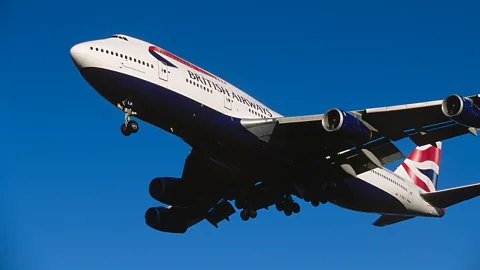 Getty Images
Getty ImagesIt became an icon of long-haul travel and exotic holidays; Boeing’s 747 could fly more people further than any plane before. Stephen Dowling looks back at an aviation classic 50 years after it was first unveiled.
BBC Future has brought you in-depth and rigorous stories to help you navigate the current pandemic, but we know that’s not all you want to read. So now we’re dedicating a series to help you escape. We’ll be revisiting our most popular features from the last three years in our Lockdown Longreads.
You’ll find everything from the story about the world’s greatest space mission to the truth about whether our cats really love us, the epic hunt to bring illegal fishermen to justice and the small team which brings long-buried World War Two tanks back to life. What you won’t find is any reference to, well, you-know-what. Enjoy.
It is 30 September 1968, and a crowd of thousands has gathered at the new Boeing factory at Everett, about 30 miles (50km) north of Seattle. They are here to see the airline manufacturer’s radical new design.
The 1960s has seen seismic social change, the race to put an astronaut on the Moon, the tumult of the Vietnam War and the undulations of Cold War tension. Over the course of the decade air travel has gone from being the preserve of the wealthy to something much more affordable.
Key to that has been a new generation of jet airliners. They are bigger and faster than their propeller-driven ancestors, and their powerful jet engines let them fly far higher – allowing them to climb over bad weather instead of having to fly around it. That means flights to far-flung places take a lot less time than they used to.
Boeing’s 707 has been a mainstay of ever-expanding airlines since the mid-1950s, and there are rivals from the UK, France and the Soviet Union. The bigger jets are able to take more passengers, which means airports are having to grow just to keep up with demand.
You might also like:
The genesis of Boeing’s new design has come not from the airliner producer itself, but from one of its customers. Juan Trippe, the chief of globetrotting airline Pan Am, has noticed increasing congestion at airports. While the number of flights is increasing, the aircraft themselves can carry only relatively small numbers of passengers. A bigger plane will help the airlines keep down running costs.
Trippe asks Boeing to design something completely different – a super-sized airliner twice the size of the Boeing 707.
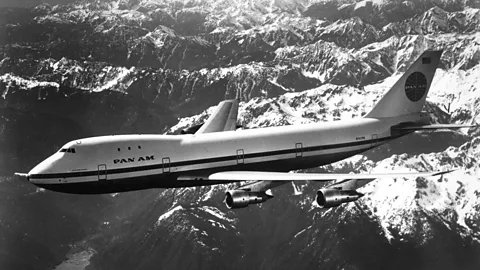 Getty Images
Getty ImagesThe plane that Boeing unveils on this September day will become synonymous with the glamour of long-haul travel – the plane that can take you to sunny beaches a continent away. It will redefine the shape and size of airports, and become an unsung stalwart of the world’s cargo freighters, moving vast amounts of goods across the world to this day.
It will become a household name thanks to a play on its elephantine size; the ‘Jumbo Jet’. But as far as Boeing is concerned, it’s called the 747.
***
The beginnings of the 747’s story, however, began with a little-known military contract.
In the early 1960s, the US Air Force was just starting to take delivery of the Lockheed C-141 Starlifter, a huge four-engined jet designed to carry 27 tonnes of cargo over distances of some 3,500 miles (5,600km). But the air force needed something even bigger.
In March 1964 it invited aircraft builders to submit designs. The new plane would have to be able to haul 52 tonnes of cargo 5,000 miles (8,000km) – or be able to take off with 81 tonnes of cargo onboard for shorter missions. On top of that, the plane would have to have a cargo hold 17ft (5.18m) wide by 13.5ft (4.1m) high and 100ft (30m) long – big enough to comfortably drive a tank into. And it would need to have cargo ramps both front and back so vehicles could be driven in or out at either end.
Boeing tendered a design for this giant freighter, alongside rivals Douglas, General-Dynamics, Lockheed and Martin-Marietta. Boeing, Douglas and Lockheed’s designs were all selected for further study and each of them had a different approach to a central problem – where do you put the cockpit when you have to have a cargo door at the front of the plane.
Douglas’s design had a pod on top of the fuselage ahead of the wing, while Lockheed’s design had the cockpit and a cabin for additional passengers in a long ‘spine’ that ran most of the length of the aircraft. Boeing chose something somewhere between the two – and this would later work out to be very wise decision indeed.
Lockheed’s design won the military competition (their submission would become the C-5 Galaxy, the biggest aircraft in the world for the next two decades) but Boeing’s submission was to influence another aircraft with a very different role.
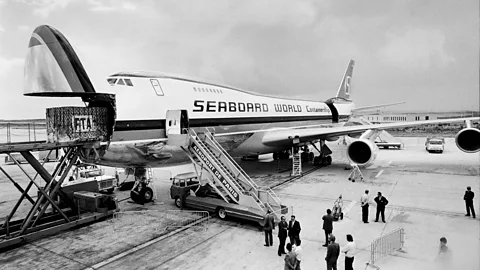 Getty Images
Getty ImagesIn 1965, Boeing engineer Joe Sutter, who had been working on the new 737 short-haul airliner, was brought in by Boeing’s president Bill Allen to work on a new project. This was a giant airliner inspired by the demands of the military contract, and Juan Trippe’s desire for a congestion-busting passenger plane.
Sutter and his team’s work began partly inspired by the military design. It kept the high flight deck and the opening nose doors, and the ‘high-bypass’ engines developed for the military freighter (‘high bypass’ engines circulate the air around the turbine as well as through it, creating much more thrust for the amount of fuel burned). Sutter realised, by talking to potential customers such as Pan Am, that the airlines needed a plane that could carry many more than the 190 passengers the 707s currently plying the airways. There would be less congestion, and more passengers per flight meant the cost per passenger would go down. The bigger jets would be cheaper to run.
But there was an added complication.
At the time, Boeing was working on an even more ambitious project, says Mike Lombardi, Boeing’s resident historian. “Boeing were also building their SST (Supersonic Transport) which was supposed to compete with Concorde. The thinking at that time was when Concorde and the SST went into service, people would want to fly on them, and they wouldn’t want to fly on an airliner that was subsonic.
“Sutter realised that, one day, these planes would have to become freighters.”
This meant the new jumbo-sized airliner would have to keep the same configuration as the freighter, with the cockpit above the passenger cabin, because of the realisation that their days as an airliner would be numbered.
“Making sure the 747 could be a good cargo airplane had a tremendous influence on the design,” says Lombardi. It was an insight that would also help to ensure the success of the 747.
The Boeing SST, known as the 2707, never made it to airline service, by comparison. Environmental concerns about the noise created by sonic booms – and the prodigious fuel costs – killed the aircraft before it ever flew. (Read: The American Concordes that never flew)
Even before they were able to build the 747, Boeing had something else on their to-do list – build a factory big enough to assemble them.
 Getty Images
Getty ImagesThe 747 was so big – 231ft (70.6m) nose to tail and a wingspan of 195ft (59m) – that it couldn’t be built in any of Boeing’s existing facilities. They had to build a completely new assembly plant, big enough for factory-fresh 747s to be rolled out at the end of it. “Not only were they building one of the world’s biggest airplanes but they were also putting up the world’s biggest building to assemble them,” says Lombardi. The Everett plant is still the biggest enclosed building in the world.
The 747’s construction came at an ambitious time for Boeing, says Lombardi. Not only was it having to oversee the 747 project (and the building needed to assemble it) and the ill-fated SST programme, but it was also building the new short-to-medium range 737 and systems used on the Apollo Saturn space programme.
And all this time, Boeing was burning through cash. To help fund the 747 project it borrowed from no fewer than seven banks.
Sutter, who became known as ‘the father of the 747’, fought to keep his engineers from being hived off to other projects. “With all this other business at Boeing, there wasn’t just a shortage of funding, there was a shortage of engineering talent,” says Lombardi. “All of the engineering talent was going to the SST project. Joe Sutter had to really fight to get engineers to work on the 747.
“I heard a story that he went to one meeting and during it he was told he had to give up more engineers to other programmes,” says Lombardi. “He says: ‘Then I can’t build it [the 747]’.
“He stood up and said ‘no’, and left the meeting, thinking that that was it, he was going to be fired. But Bill Allen said to him, ‘I really respect what you did in front of all those people’.” Sutter kept his job.
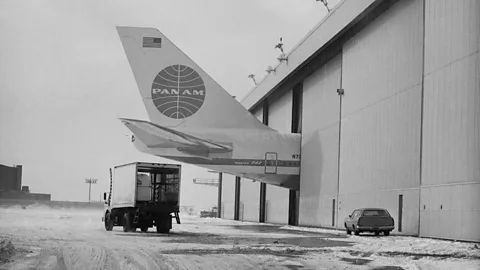 Getty Images
Getty ImagesAfter the rollout in September 1968 – when the world got its first glimpse of the giant airliner – the next milestone came in February 1969. Test pilots Jack Waddell and Brien Wygle took the 747 on its maiden flight from the Everett site.
“There is a story that before the first flight Bill Allen told Jack Waddell, ‘I hope you know how much is riding on this’,” says Lombardi. “As if there wasn’t enough pressure already!”
Boeing’s jumbo-sized airliner proved it could fly, but would the world’s airliners now buy it?
Pan Am was the lead customer – Boeing had promised it would deliver the airline’s order by the end of 1969. The aircraft had had to be designed and built in only 28 months, as opposed to the usual 42 months for a new passenger aircraft. Boeing proceeded at such a pace that the first 747 was being built at its giant facility in Everett before the building’s roof was finished.
Other airlines decided that they too wanted a piece of the ‘jumbo jet’ action. One of them was British Airways. And a young maintenance engineer called Stewart John was sent out to Seattle to get to grips with the new aircraft.
“I was invited to go over to Seattle, around the [time of the] second production example, which was in Pan Am colours, was being flown,” John tells BBC Future.
“Everett had just been built. There were two of us from BA and there were others from Lufthansa, Qantas, American Airlines and Delta.
“We were doing a lot of familiarisation in a classroom. One Friday there was a whisper that went around class: ‘They are going to fly the second one today.’
“So we all went out to end of the runway. We couldn’t believe the size of it. When that thing went over the top of you, it was amazing.”
There had been initial resistance to the 747, especially by some US airlines, because of its enormous size – there were concerns most airports wouldn’t be able to accommodate it. But Boeing was convinced those airlines having to cross oceans – like those flying from New York to London and back again – would see the benefits of such a large aircraft. One major factor in its favour was the fact it could carry up to 550 passengers, nearly four times as many as the 707.
 Getty Images
Getty ImagesOn 15 January 1970, Pan Am’s first 747-100 (the first 747 model to go into service) was officially christened by US First Lady Pat Nixon. The airline’s 747s began flying their first route, between New York and London, one week later.
But the 747 wasn’t out of the woods just yet. Boeing’s big spending on the project – it owed $1.2bn to banks, a record at that time – came just as the US entered a recession. The 747 wasn’t cheap. Each plane cost $24m, the equivalent of $155m (£117.8m) in 2018. Boeing only sold two 747s for a year and a half from September 1970. Other airlines that had bought the plane rapidly swapped them for smaller aircraft as the 1973 Oil Crisis led to higher fuel prices.
Even British Airways, the airline that would go on to fly more 747s than any other, had troubles with the aircraft.
“We ordered three planes from the first 20 built,” says John. “There were terrible engine problems at first. (Then) there was a pilot’s strike at BA – they wanted a lot of extra money to fly them.
“The planes just sat there – we ended up leasing the engines of our planes to Pan Am. Ours sat at the airport with concrete blocks on the wings, waiting for engines.”
Other customers found that one of the selling points of the aircraft – that it would cost less to operate because it could carry more passengers – was only true when the plane was fully loaded. A 747 that was 70% full still burned almost as much fuel as one full to capacity.
But the 747 saw off these bumps. Boeing needed the 747 to be a success, so it tweaked the design and listened to suggestions from airline customers. Japanese airlines wanted to use 747s as short-range commuter jets with the maximum number of seats – 550 – so Boeing made a shorter version that could carry less fuel but more luggage. The 747-200 followed in 1971, with more powerful engines and with a much higher maximum take-off weight.
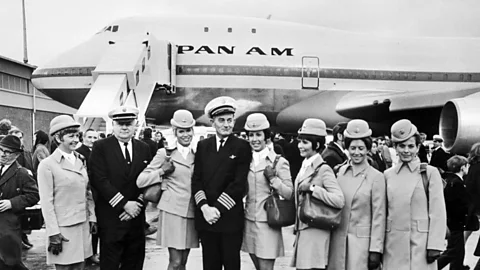 Getty Images
Getty ImagesMore and more airlines added to Boeing’s order books. Throughout the 1970s and 80s the 747’s distinctive humped shape became a byword for long-haul luxury. 747 cabins were spacious, and the plane even had a spiral staircase to access the upper deck.
In order to encourage people to fly on the giant planes, some airlines took advantage of the 747’s size to bring previously unthought of levels of luxury. American Airlines 747s had a piano bar in economy class in the 1970s; Continental’s models had a lounge with sofas.
Robert Scott was one pilot who flew the giant airliner. “Our airline was one of the first to introduce the 747 into service and we were pretty excited to be flying what was indisputably the biggest and best airliner in the world at that time,” he tells BBC Future.
“It was staggering to stand and contemplate its size. It was literally like a block of flats. My early flying was in the Fleet Air Arm of the Royal Navy so I was used to aircraft that were considerably smaller than the 747. I had flown other civilian aircraft before going to Boeing for the 747 course but nevertheless nothing came close, size-wise.
“Despite its enormous size it was delightful to fly. One approached it with a certain amount of trepidation from the handling point of view, expecting that it could not only look like a block of flats but also fly like one. So it was a wonderful surprise to find that it handled like a much smaller aircraft and was delightfully manoeuvrable. It was really only when it was on the ground that one was aware of its enormous size and the care that had to be exercised, especially in restricted spaces.”
Airlines continued to order the 747, and airports lengthened their runways and increased the size of their terminals to accommodate it. And Boeing continued to tweak the design as technology improved.
By the mid-80s Stewart John had left British Airways for a new job at Cathay Pacific in Hong Kong.
“In 1986 I started talking to Boeing about whether they could do a massive change with the design.
{"image":{"pid”:”p06m9q1m"}}
“In Hong Kong we were really pushing the 200 to its limits in terms of range. We were flying from Hong Kong to Vancouver, Vancouver to Hong Kong. On the way back it took about an hour-and-a-half more because of the prevailing winds. The punishing trip was always the West Coast of the Americas travelling back to East Asia.”
“Cathay had the longest routes in the world, so Boeing sent a team to come and talk to use to see what they had to do. They came up with the 747-400 and we were the launch customer for the Rolls-Royce-powered version.”
The 747-400 was a huge step forward. Nicknamed the ‘Longreach’ by some airlines, it could fly non-stop for 7,670 miles (14,200km) at maximum capacity. It did this partly by adding ‘winglets’ on the end of the wings, which improved aerodynamics and meant the aircraft burned slightly less fuel per mile. If airlines wanted to, they could fit 660 passengers in an all-economy-class layout. First flying in 1988, the 747-400 was a huge success; almost 700 were sold. Many are still in operation today.
“Cockpit and systems redesign meant that the flight engineer was no longer required,” says Scott. “Not only was there a financial saving with crew costs but this was a demonstration that technology was shaping the future of aircraft design like never before.”
A further refinement to the 747 came in 2005, with the launch of the 747-8; by now, Sutter’s hunch that the aircraft would one day be needed as freighters had come true – Boeing offered the 800 as a freighter from new, rather than freight operators having to strip out the passenger cabin on planes ending their career as airliners.
But by 2005, the ‘jumbo jet’ was no longer in a class of its own. Boeing’s European rival Airbus had designed its own super-sized airliner, the A380; it can carry up to 853 passengers. Like the 747 before it, its huge size has meant airports have had to adapt to operate it.
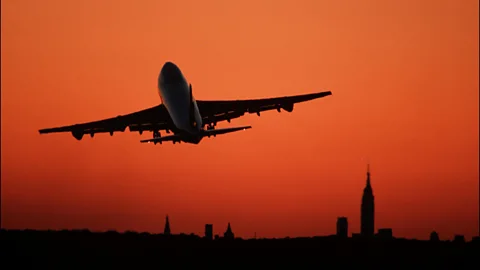 Getty Images
Getty ImagesBut the aviation market has changed a lot since the 747 was designed. Back then, no twin-engined aircraft were allowed to fly further than 60 minutes reach of an airport, in case there were problems with the engine. Now, airliners like Boeing’s 777 or 787 are able to fly as much as five hours away from the nearest airport – which means they can cross vast oceans like the Atlantic and Pacific.
Air travel is changing too. The advent of the 747 and the A380 led to giant hub airports, which jumbo-sized airliners would fly between. Passengers going to smaller airports would then catch a flight on much smaller plane. It has helped to shape the classic ‘hub-and-spoke’ system that defined air travel over the last 40 years.
But in recent years things have changed. Smaller two-engined aircraft are now able to fly much further; and because they only need two engines, they’re cheaper for the airlines to run, so destinations are becoming more varied. It means non-stop long-haul flights from places such as London to Nashville – a distance of 4,200 miles (6,720km) – are now possible on twin-engine planes.
Suddenly, giant airliners flying from sprawling airport to sprawling airport look a little vulnerable. Airbus has started seeing the effects on its assembly line; apart from an order for 20 A380s for Emirates in January 2018, Airbus hasn’t sold any of its giant airliners for more than two years. And some of those who have bought the plane are cancelling orders.
The 747’s saving grace is that it is a relatively easy aircraft to convert into a freighter.
“You can carry passengers, and if you can’t carry passengers you can carry freight and if you can’t carry freight you can carry fuel,” says John. “The A380? You can’t carry freight in that.”
The Boeing 747 assembly lines won’t go quiet just yet, but it’s likely that by 2020 most of the remaining 747s built will be cargo versions or private jets for governments and the super-rich. With it will come the end of Boeing’s 50+ years building jumbo-sized jets; the company’s plans for the next two decades don’t mention any planes of a similar size. But as of 2018 more than 1,500 have been delivered.
“While some may feel nostalgia for the bars and grand pianos that graced the 747, especially in its early days, economics dictate the shape - and size - of things to come,” says Robert Scott. “Those of us with a place in our hearts for the dear old 747 will have to bid farewell to an aircraft that established standards that seemed impossible only a generation ago.”
In the meantime, Sutter’s creation will continue to loom over the world’s airport terminals. And every time Mike Lombardi sees one, he’ll be reminded of the designer whose determination ensured that the 747 took flight.
“A couple of years ago I was due to fly out to London from Seattle. Just before I was about to make that trip, Joe Sutter passed away. Joe was like a kindly uncle, he really took me under his wing. I saw that 747 taxiing towards me, and I thought of Joe, and it was a very emotional moment.”
Lombardi says those 747s remaining – increasingly flying freight rather than passengers – will be in service for many years to come. Future generations will share his own memories as a child, watching a 747 climb into the air and wonder how it stays aloft.
“Even when you understand all the science of airplanes, I still think there’s a little bit of magic there too.”
--
If you liked this story, sign up for the weekly bbc.com features newsletter, called “If You Only Read 6 Things This Week”. A handpicked selection of stories from BBC Future, Culture, Capital, and Travel, delivered to your inbox every Friday.
